Honeycomb: The Intricacies Of Nature’s Architectural Wonder
Since the beginning of time, the honeycomb has been a source of fascination for mankind due to its complex hexagonal cells and inherent symmetry. Honeycomb, in addition to the pleasant things that it contains, is a marvel of the engineering that nature has done. Over the course of this blog post, we dig into the intriguing world of honeycomb, investigating its structure, creation, importance, and the wonders that it has.
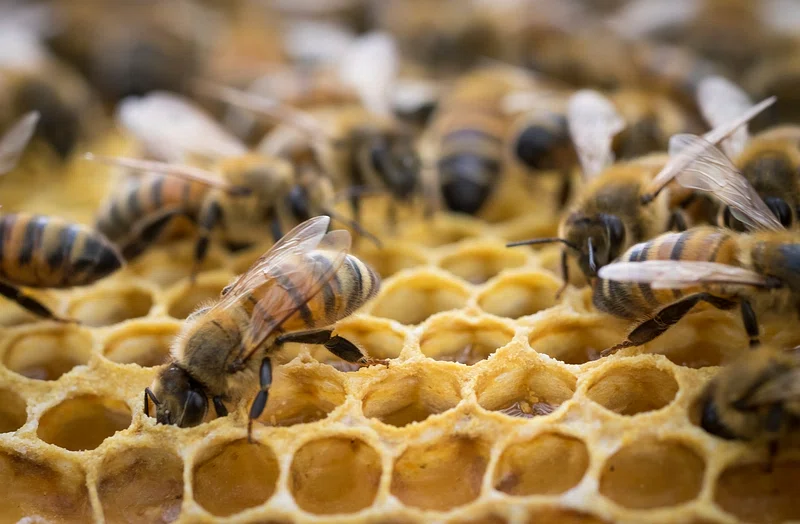
The Structure of Honeycomb:
At first glance, a honeycomb would seem to be a pattern of hexagonal cells that are uniformly distributed. The honeybees, on the other hand, have painstakingly created a complicated structure, which is revealed upon closer study. Every cell is properly proportioned and structured, which maximizes the use of space while also enhancing the strength of the structure. In addition to maximizing the storage capacity of honey, pollen, and larvae, the regularity of hexagons helps to reduce the amount of material that is used.
Formation Process:
The coordinated efforts of honeybee colonies’ cooperative efforts result in the spectacular accomplishment of honeycomb production.The abdomens of worker bees are responsible for the production of beeswax, which the worker bees then shape and mold into the characteristic hexagonal cells. Festooning is a mechanism that bees use to join together in chains in order to create and measure cells with an extraordinary level of accuracy. The honeycomb that results from this collective effort serves as evidence of the extensive social order that exists inside bee colonies.
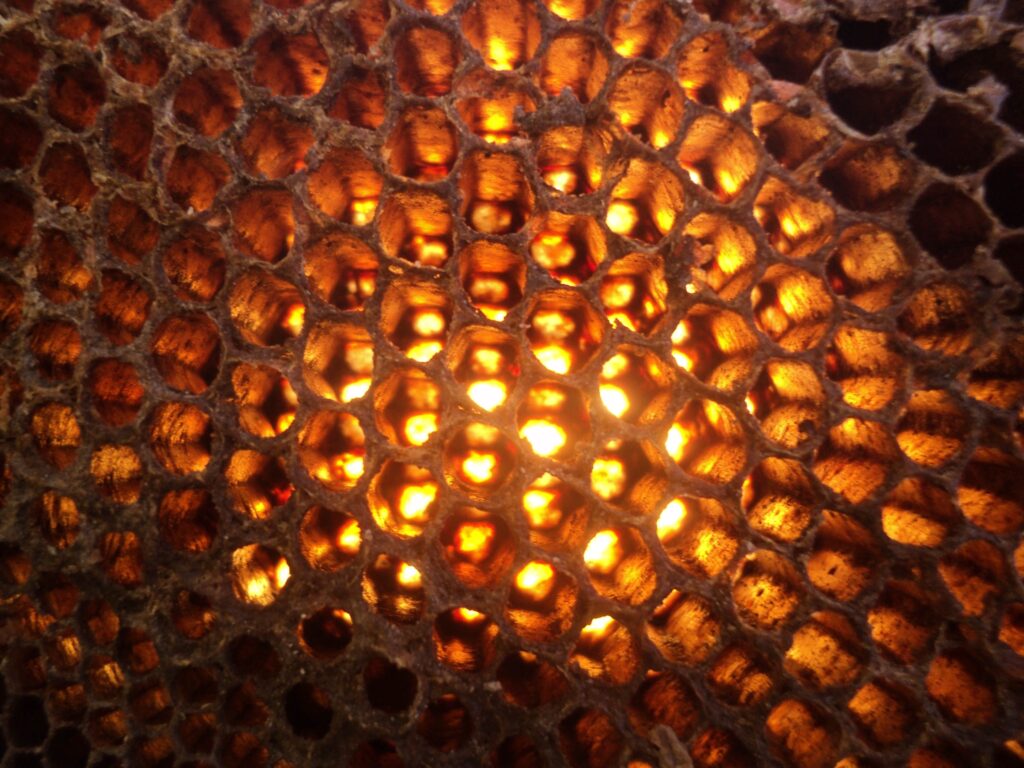
Significance in Bee Colonies:
Honeycomb is the foundation of bee colonies, and it plays an essential part in the bees’ ability to ensure their continued existence and increase their output. It is a nursery for the purpose of rearing young bees and also serves as a storage facility for honey, which is the major source of energy for bees. In addition to facilitating ventilation and temperature management, the hexagonal cells also serve as a defensive mechanism against both predators and pests. Additionally, honeycomb is a key component of beekeeping techniques since it provides beekeepers with valuable information about the health and production of the colony.
Ecological Importance:
Honeycomb is important to bee colonies, but it also serves a function in the environment that is more widespread. As pollinators, bees play an important role in the reproduction of a vast number of plant species, including a significant number of the fruits, vegetables, and flowers that are vital to the functioning of ecosystems and agricultural systems. The production of honeycomb assists in the maintenance of bee populations, which in turn helps to maintain biodiversity and the stability of ecosystems. As a result, honeycombs are a prime example of the interdependence of different species and the fragile equilibrium that exists throughout natural ecosystems.
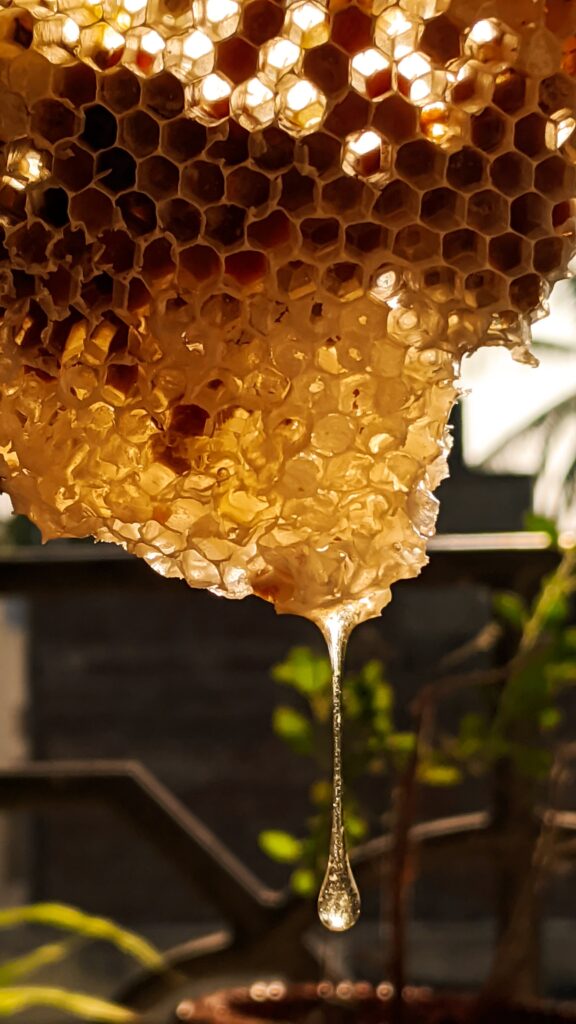
Cultural and Symbolic Significance:
Honeycomb has been accorded cultural and symbolic importance in a number of different civilizations over the course of history. The therapeutic benefits, culinary applications, and symbolic links with sweetness, abundance, and fertility that honey has have earned it a place of reverence in a great number of civilizations. Symbolic of harmony, order, and divine creation, honeycomb themes may be found in a variety of artistic and architectural expressions, as well as in religious symbolism. Its geometric perfection has served as a source of amazement and adoration for humans, as well as a source of inspiration for human ingenuity.
Conclusion:
In conclusion, honeycomb is a fantastic example of the inventiveness of nature and the capability of honeybee colonies to do incredible things. Because of its complicated structure, construction process, role in bee colonies, ecological significance, and cultural symbolism, it is a topic of study and appreciation that is both interesting and admirable. While we are in awe of the honeycomb’s incredible beauty and complexity, let’s not forget to recognize the significant contribution it makes to the preservation of ecosystems and the advancement of human civilization.
Table of Contents
How to get Honey Comb?
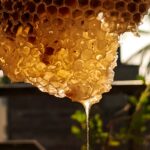
Work with honeybee hives to get honeycomb. The general process of making honeycomb:
-The first step is to find beehives where honeybees have built honeycomb. Beehives may be found in natural environments, apiaries, or hollow trees or buildings.
Managed Colony Honeycomb Harvesting:
-Beekeepers check managed colonies for honey extraction readiness.
-Bee suits and veils are used to prevent bee stings.
-Beekeepers carefully remove honeycomb frames from hives. Frames are generally part of a hive body or super.
-Bee brushes and smokers may gently remove bees from frames.
-Honey extraction occurs in a processing plant after frames are removed.
Extracting Honeycomb:
-In the processing plant, honeycomb frames are extracted for honey.
-Most extraction procedures include centrifuging frames to liberate honey while retaining the comb.
-After extraction, frames may be returned to the hive for bees to refill or reuse.
Package and distribute:
-After honey extraction, the honeycomb may be marketed as “comb honey.”
-Comb honey is sold to natural honey lovers.
Honeycomb harvesting should be done ethically and sustainably to protect bee populations and habitats. Aspiring beekeepers and honey aficionados should also research local beekeeping legislation and consult with expert beekeepers or agricultural officials.
How to draw a Honey Comb?
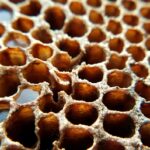
To draw a honeycomb:
-Start by drawing a single hexagon.
-Repeat the hexagon pattern, connecting each hexagon side by side to create rows.
-Add lines inside each hexagon to represent the cell walls.
-Consider adding shading or color for depth.
-Optionally, outline your drawing with a pen or marker.
-Erase any remaining pencil lines.
-Admire your finished honeycomb drawing!
Where to get Honey Comb?

Honeycomb may be obtained from a variety of sources, such as:
Beekeepers in the area:
Beekeepers sometimes market honeycomb as a niche product, selling it at farmers’ markets, roadside stalls, or directly from their own apiaries. Local beekeepers may often be located via internet listings or by inquiring at agricultural supply shops.
Specialty food stores:
Honeycomb may be found in some specialized food shops, gourmet markets, or natural food stores that provide a variety of honey options. Inspect the honey or natural foods department of these shops to see whether they carry honeycomb.
E-commerce platforms:
There are a plethora of e-commerce platforms that specialize in the sale of honey and honey products, including honeycomb. Honeycomb may be purchased via online platforms like as Amazon, Etsy, or specialized honey merchants, where it is often supplied from different beekeepers and areas.
Agricultural markets:
Farmers’ markets are optimal venues for sourcing honey and honeycomb that are produced locally. Beekeepers often sell their goods directly to customers at these markets, offering a chance to get freshly harvested, locally-sourced honeycomb.
Apiaries or Honey Farms:
Certain apiaries or honey farms provide guided tours and have on-site retail establishments where visitors may get honey and honeycomb merchandise. If there are any apiculture establishments or apiaries in your vicinity, contemplate contacting them to inquire about the possibility of purchasing honeycomb straight from them.
When buying honeycomb, it is crucial to take into account aspects such as freshness, quality, and sustainability. Whenever feasible, choose honeycomb that is ethically obtained and manufactured by beekeepers and emphasizes the welfare of their bees and the ecosystem.
Suggestion-
